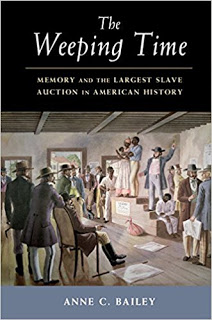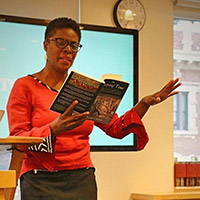The Weeping Time: Memory and the Largest Slave Auction in American History is a story of fragments – fragments of history and narrative that periodically break the silence on the period of slavery. This is why the auction seemed so significant to me when I first stumbled upon the topic in 2006 while perusing the website of Thomas Jefferson’s Monticello. At the time, I was more interested in learning about Jefferson’s relationship with his slave, Sally Hemings. Then I read the short biography of his life and the last lines literally jumped off the page.
Here is an excerpt from The Weeping Time:
“As for the rest of his slaves- 140 men, women and children because Jefferson was heavily indebted, they were to put up for auction.”
AUCTION.
It was not a word that I was searching for. I had been more interested in seeing the latest updates on the Hemings family and was impressed by these additions, yet now the word “auction” had taken center stage. A word that carries so much weight yet was a dreaded word. A word that captures the essence of the objectification of slavery for surely only objects are auctioned, not people. The word auction reminds us that there was a time when people had a price.
This one word in one line of Jefferson’s will may have meant little more than that—the disposal of property whose labor was no longer needed or who were needed now to pay his debts- but for all of African descent since the beginning of slavery as an institution in 17th century America, this word was to be feared as much as death itself. In fact, it was considered a kind of death since separation from loved ones was most often permanent. Loved ones, family, kinship ties – all this was treasured from the African experience as it migrated across the Atlantic –yet those ties could vanish at the stroke of an auctioneer’s hammer.
The auction block is all but forgotten in American memory yet the average American slave could be sold as many as six times in a lifetime and not because he or she likely did not do all in his or her power to prevent these sales from taking place. We know many slaves like Nat Turner and Denmark Vesey resisted their enslavement but there might have been many more had the specter of the auction experience not hung over them and their families like a dilapidated roof. How many more uprisings big and small might have taken place had this not one word -auction—caused dread in even the most fearless African warrior? Or conversely, how many revolts were set in motion precisely because of the threat of auction block?
Fixated on this term, I decided to bring this fragment of the African American experience front and center. Even those African Americans that live in a state of denial about slavery and its impact tend to be jolted back to this part of their history with the word “auction.
But this story is not just about the past. It is about the ongoing attempts to restore and recover pieces of the past.A story of fragments but also a story of resilience.
Anne C. Bailey
personal website: https://annecbailey.net




 Find Anne C. Bailey's non-fiction book :
Find Anne C. Bailey's non-fiction book : 



